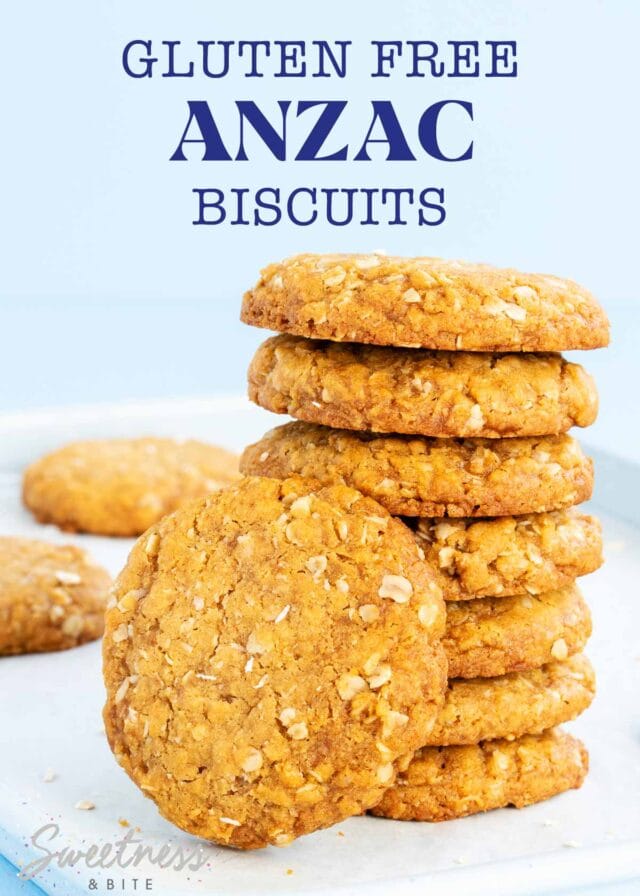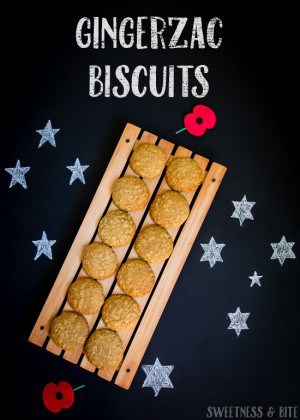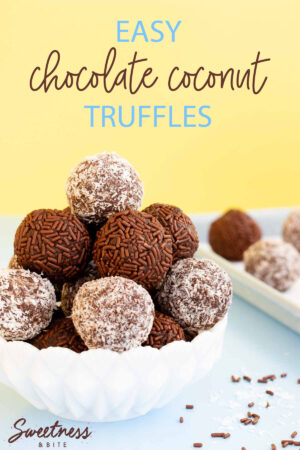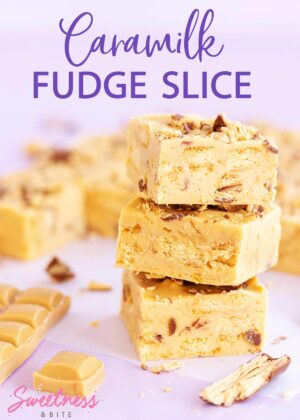Gluten Free Anzac Biscuits
This post may contain affiliate links to products I recommend. I receive a small commission at no cost to you if you make a purchase using my link.
A classic Kiwi and Aussie favourite, these Gluten-Free Anzac Biscuits are everything you love about the traditional, easy to make oaty biscuit, in gluten free form.
Includes options for Coeliac-safe, oat-free biscuits.

One of the biscuits I missed most when I stopped eating gluten was a good old fashioned Anzac biscuit. They’re such a New Zealand classic (and an Australian classic too, of course) and something most of us grew up eating.
Packaged gluten free Anzac biscuits were hard to come by for a while, and the ones that are available now are still not a patch on a nice homemade biscuit.
There’s really nothing like tucking into a warm Anzac biscuit not long out of the oven, and the smell they leave in your house while they’re baking is like a warm hug. From someone you like. Not a weird stranger hug. No one wants those.
These Anzac biscuits are everything you love about the traditional biscuits, but without the gluten.

If you’re unfamiliar with ANZAC biscuits, these are biscuits that were said to have been sent from soldiers’ families to the men of the Australian and New Zealand Army Corps (ANZACs) fighting during World War I.
In recent years there have been conflicting opinions on whether these were the actual kind of biscuits sent to the troops or whether they were more likely to have been eaten here at home to raise money for the troops instead.
But no matter the origin story, these biscuits are a classic Kiwi favourite and are still worth making today whether you’re in NZ or Australia and commemorating ANZAC day, or whether you’re just after a delicious oaty biscuit to eat with a cup of tea.
A Note On Oats
I need to put a quick but important note here about the gluten-free-ness of these biscuits. While this recipe is gluten-free by ingredient, and oats themselves don’t contain gluten, many people who have Coeliac disease or are gluten intolerant cannot tolerate eating oats.
There are a couple of reasons for this, the first is that oats can be contaminated with other gluten-containing cereals (wheat, barley, etc.) during processing. The other is that oats contain a protein called avenin which, in some people, can trigger the same symptoms in the gut that gluten does.
Coeliac New Zealand recommends that those with Coeliac disease do not consume oats, as it can be impossible to tell whether the oats are triggering symptoms in the gut.
In our house, we’re ok with eating oats so these biscuits are fine for us, but please keep your own needs and tolerances in mind if you’re trying these biscuits.
Oat Free Gluten Free Anzac Biscuits
If you can’t have oats, you can try making these biscuits with rice flakes instead. I haven’t made Anzac biscuits with rice flakes for some time, and I haven’t been able to retest them with the flakes before posting, as with the current lockdown rules I haven’t been able to get any. I’ll do my best to test them out again and update this post when I can.
These biscuits can also be made with quinoa flakes instead. Simply swap the oats for the same measurement of quinoa flakes.
The quinoa flakes are slightly smaller than oats, but they have essentially the same texture. They do have that distinct nutty quinoa flavour though, so if you’re not a huge fan of that I would suggest reducing the amount of quinoa flakes by 25-50 grams and replacing it with the same weight of desiccated coconut.
You could also add a splash of vanilla extract to help distract from the quinoa flavour too if you find it bothersome.
Edit, Oct 2021: For a 100% gluten and oat free recipe that doesn’t use quinoa or rice flakes (spoiler alert, it uses crushed cornflakes instead!) check out the Anzac biscuit recipe on my other website, Gluten Free Kiwi Favourites. Just search “Anzac” in the search bar.
How To Make Gluten Free Anzac Biscuits
We’re using all the traditional ingredients that give Anzac biscuits their distinctive taste: butter, brown sugar, golden syrup, oats and desiccated coconut. Coconut is a bit of an optional ingredient and isn’t included in all Anzac biscuit recipes, but I’m a coconut fan, so I add it in. I’ll talk a bit more about what kind of gluten free flour to use a bit further down.
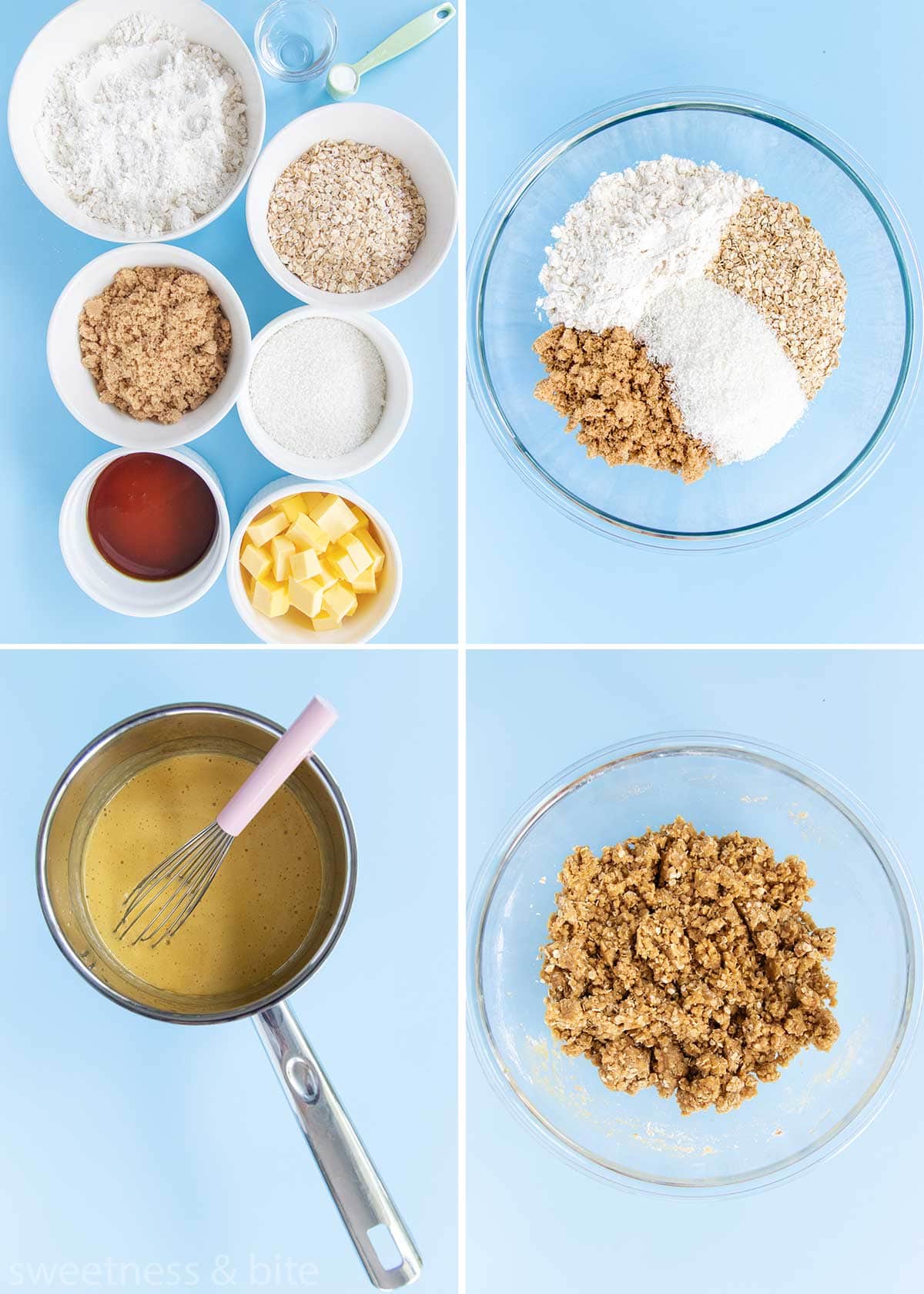
Making the biscuit dough is very easy. All you need to do is put all the dry ingredients, except the baking soda, into a large bowl, and mix them up.
The butter, golden syrup and water get heated together until the butter melts, and then the baking soda gets whisked in. The mixture will bubble up as the baking soda dissolves, and then you can pour it into the dry ingredients and mix it up.
The dough itself is quite crumbly-looking because it doesn’t contain eggs, but you should be able to squeeze and roll it into balls. If it’s still too crumbly, (which can sometimes happen, depending on the kind of flour you’re using) then you can add a little more melted butter 1 teaspoon at a time until the dough comes together.
Then just roll it all into balls. I like to use a cookie scoop to portion out the dough, but a spoon works just fine too.
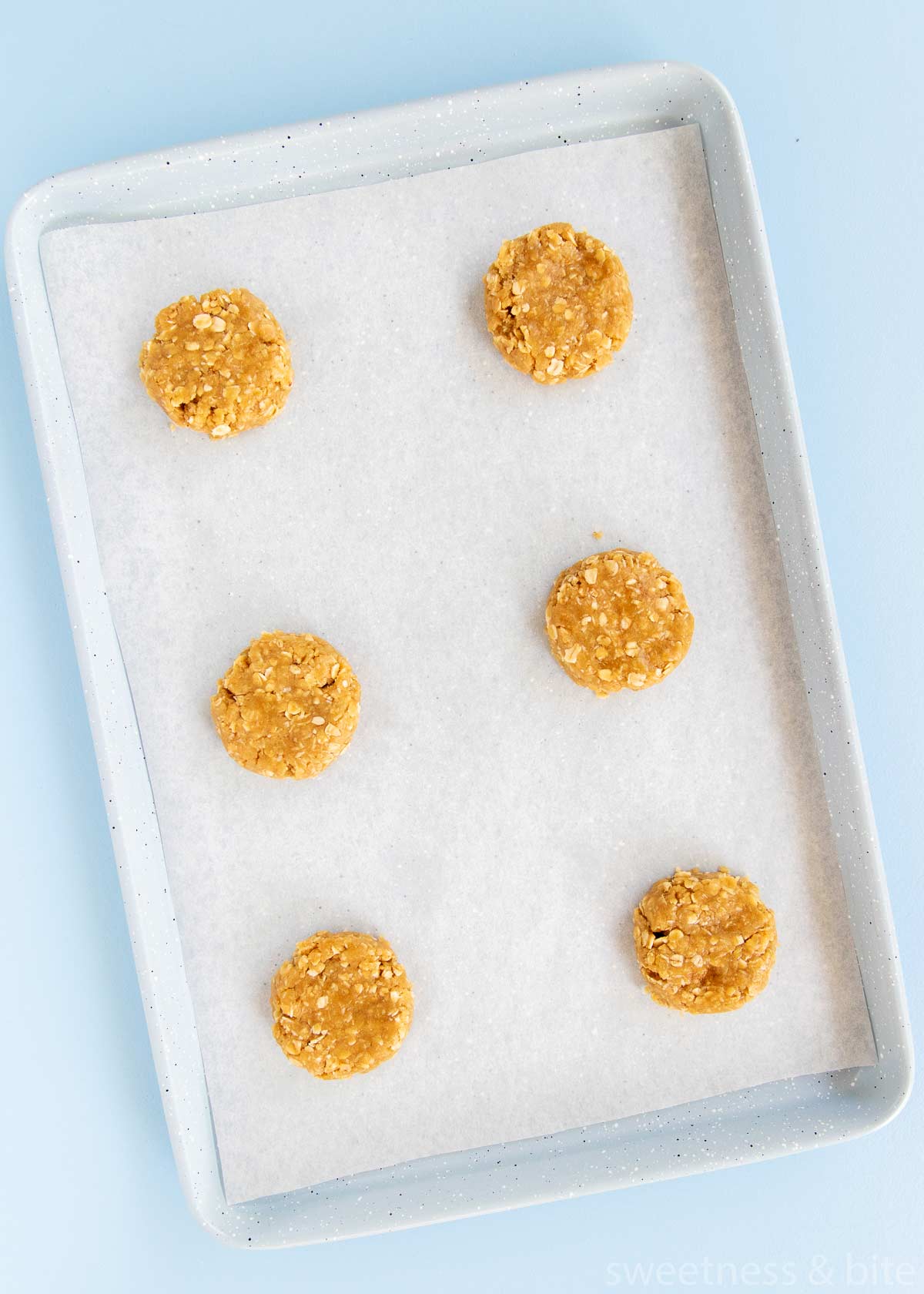
Once these biscuits came out of the oven I tried a neat trick that I read about recently on the Cloudy Kitchen blog to make the cookies pretty and rounded. Erin uses a round cookie cutter slightly larger than the biscuit and “scoots” it around the edges, to smooth them back into a round shape. This is entirely optional but a cool idea if you like nice round biscuits!
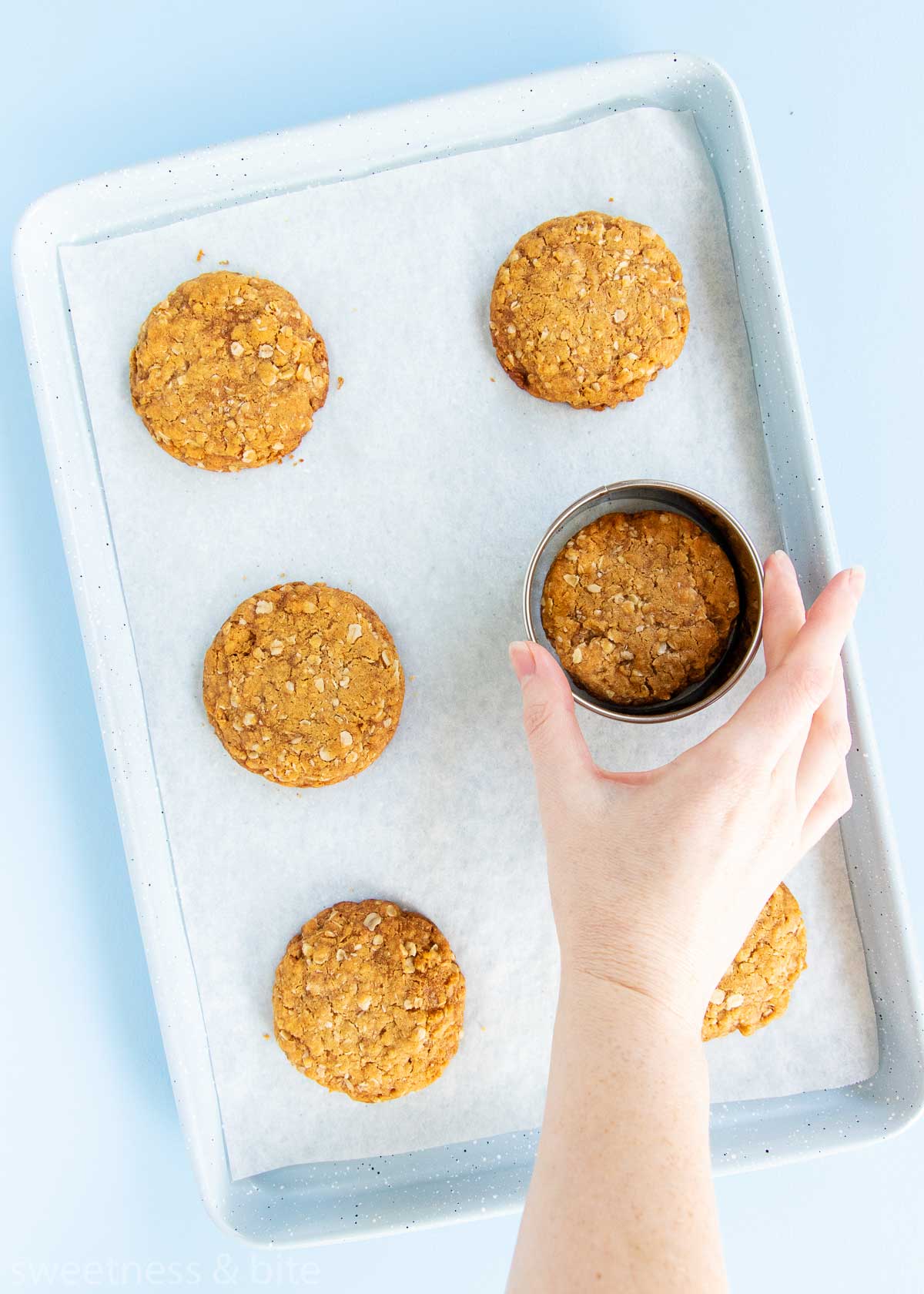
What Kind of Gluten Free Flour Should I Use?
When I make these biscuits I use my favourite gluten free flour blend for baking. It’s a combination of tapioca starch, potato starch and brown rice flour which I have found over the years to work extremely well in all of my baking recipes.
If you don’t have those flours or you would prefer to use a ready-made gluten free flour blend then you can absolutely do that. Keep in mind though that these mixes have different amounts of different gluten free flours, so you may have to play around with the recipe a bit.
If you mix up your cookie dough and it is too dry, you might need to add a bit more melted butter. If the mixture is too soft, you can either let it sit for a bit in the fridge to firm up, or add a little more flour.
My gluten free flour blend doesn’t contain any gum ingredients, as I prefer to add xanthan gum depending on the recipe and I find these biscuits actually don’t need any gum to hold them together. If you find your biscuits are a bit crumbly, you could add 1/2 a teaspoon of xanthan gum to the dry ingredients.
If you’re using a pre-prepared flour blend you shouldn’t have to add any gum, as there is usually one included in the mix.
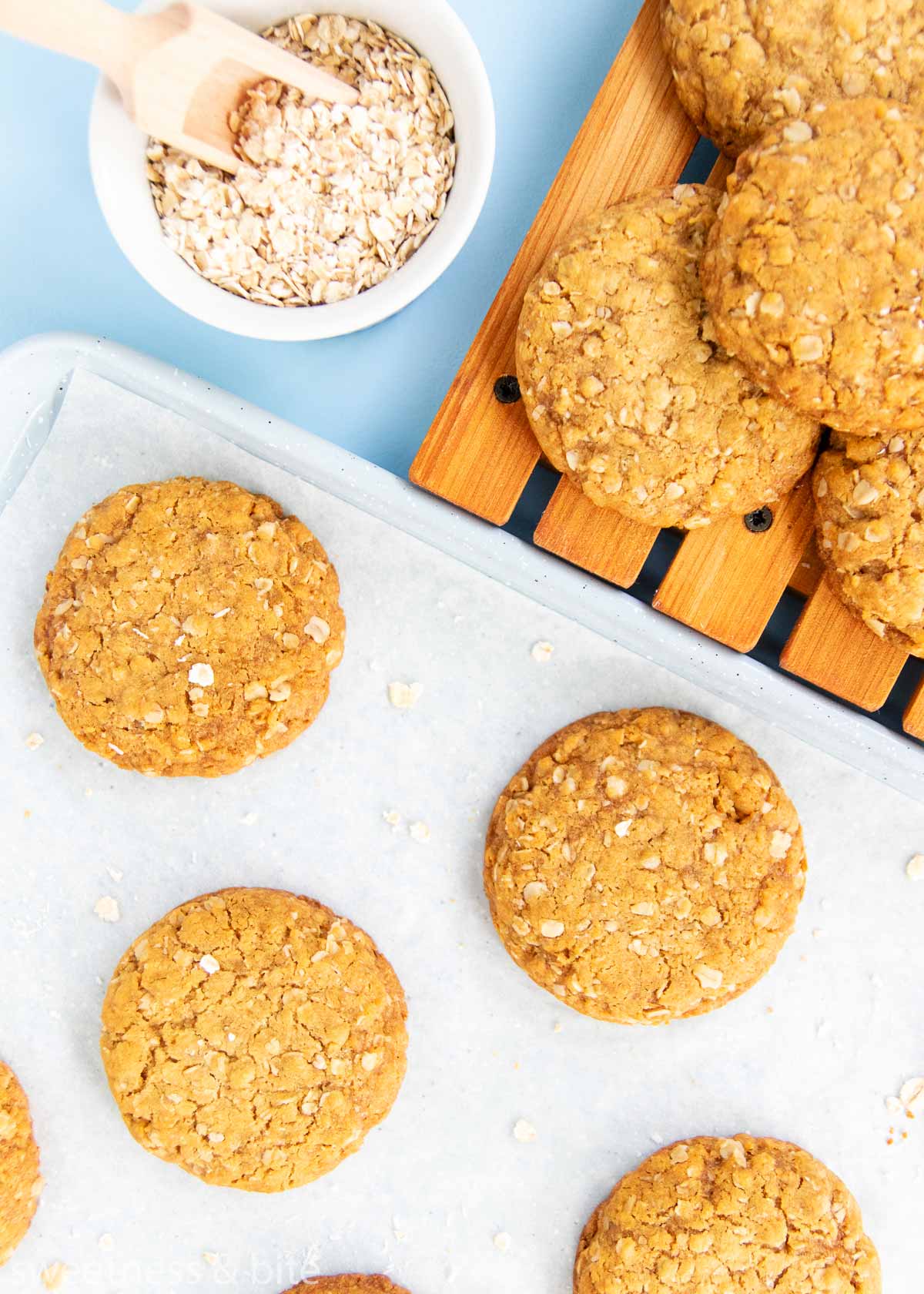
Should ANZAC Biscuits Be Crunchy or Chewy?
While I’m guessing the original Anzac biscuits were probably made to be quite dry and firm, these days, as with all biscuits and cookies, it all boils down (or bakes up?) to personal preference.
I personally like mine crunchy on the edges and softer/chewier in the middle. It’s the best of both worlds. But when I’m making these at home I always bake some a little longer to make them crunchier, as that’s how my Mum prefers them. And it earns me daughter brownie points.
If you like them soft, then aim to slightly under-bake them. If you like them crunchy on the edges and chewy in the middle, bake them until the edges are starting to go golden brown. If you like them crunchy, then bake until the edges are golden brown, and then leave the cookies to cool completely on the baking tray – this will help crisp them up even more.
Once you store the biscuits in an airtight container they will begin to soften slightly and the crunchy edges will become chewier.
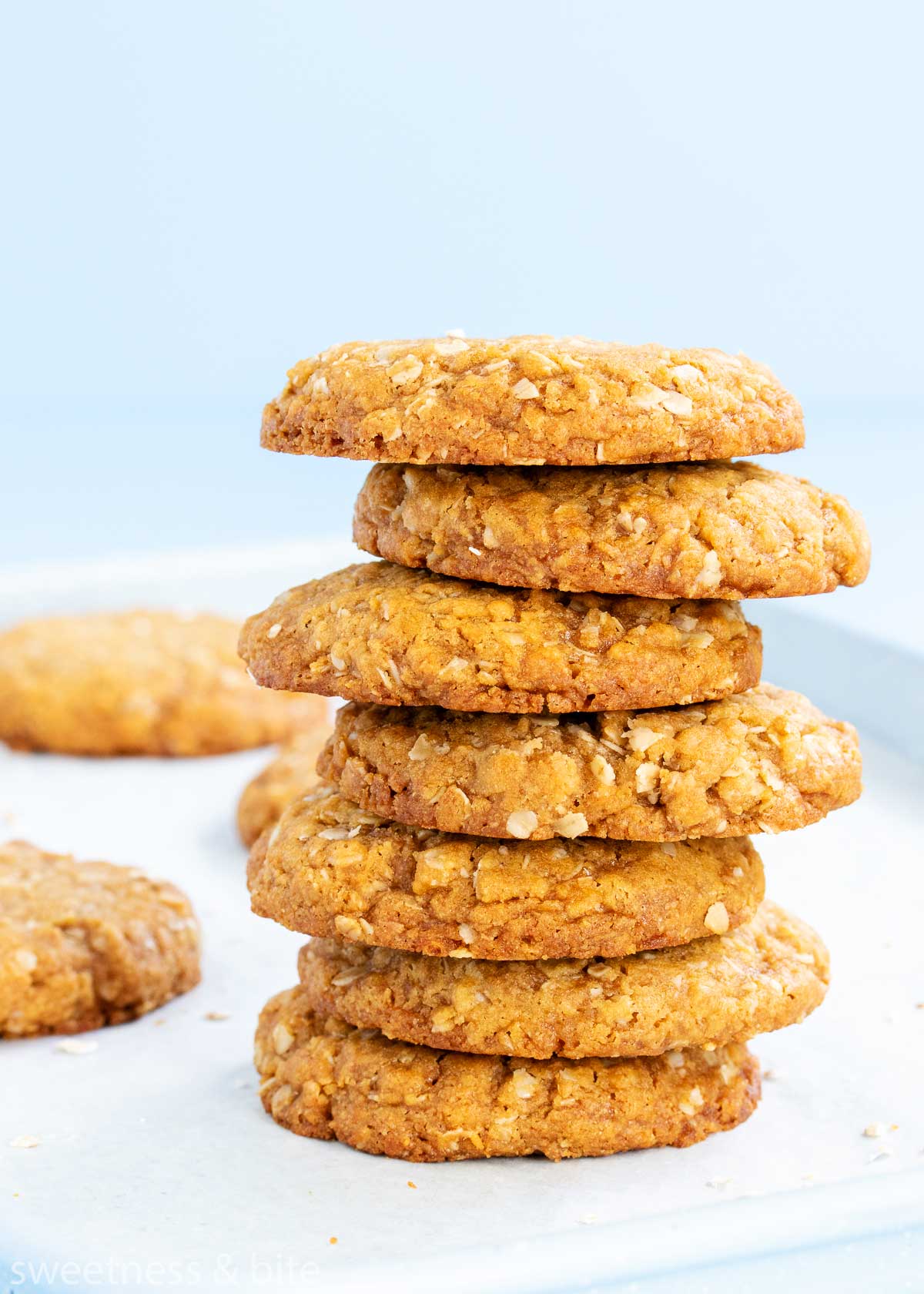
How Long Do They Keep For?
Well, this is actually a tricky one for me to confirm because these biscuits don’t actually ever last long enough to start going stale in our house, we usually eat them within a few days. But on the occasions when I’ve made larger batches, the biscuits have kept well for at least a week and should keep for longer than that.
They do tend to soften over time, but if you want to crisp them back up you can put them on a tray in the oven on low heat (100°C or so) to dry out some of the moisture and make them crunchy again.
But as with all baking, the best way to make sure it doesn’t go stale is to eat it right now 😉
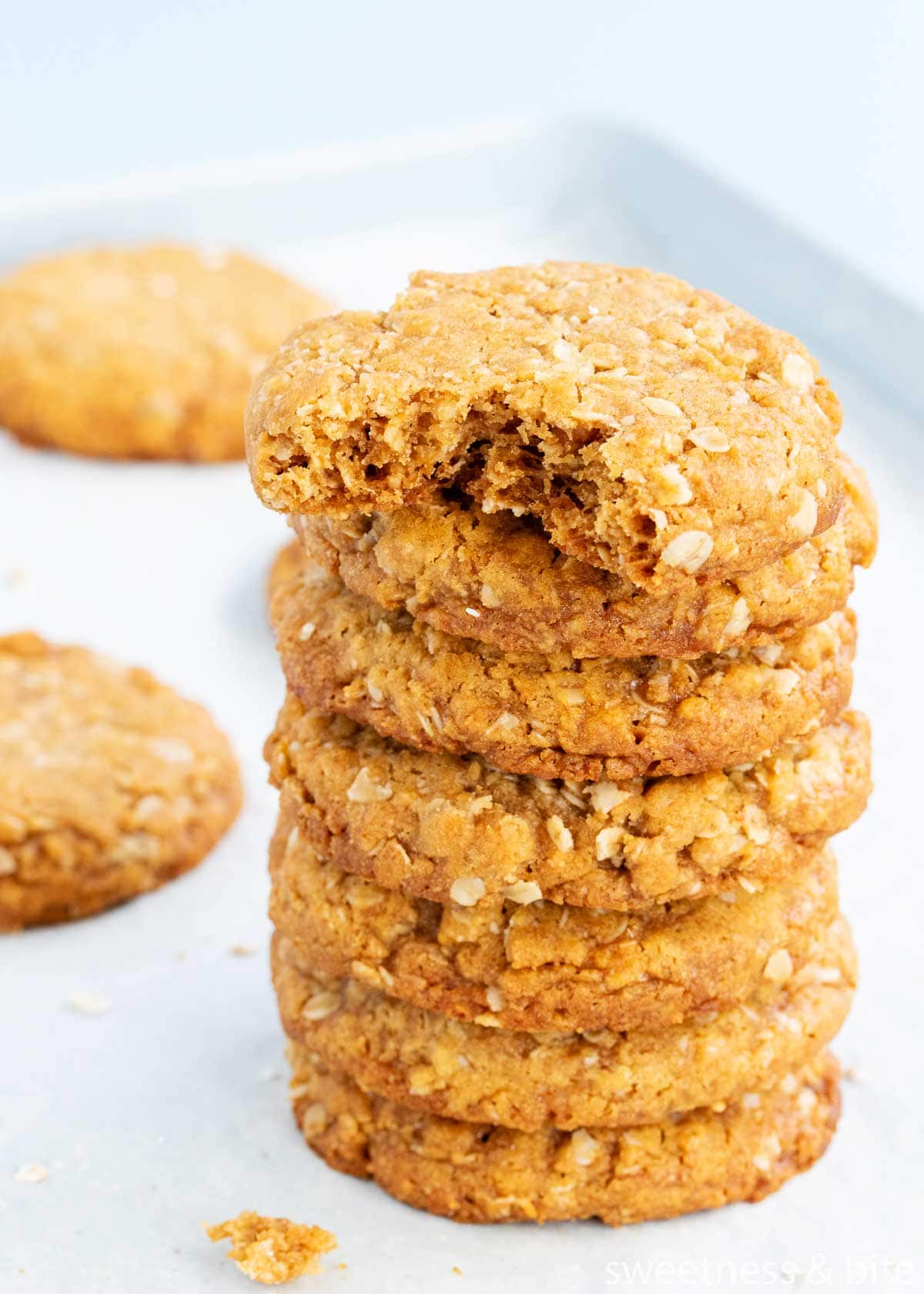
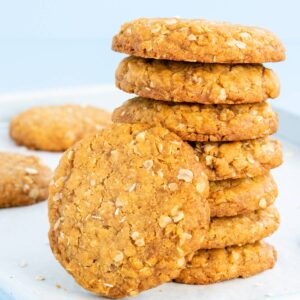
Gluten Free Anzac Biscuits
Ingredients
- 250 g gluten free flour
- 125 g rolled oats
- 180 g brown sugar
- 50 g desiccated coconut
- 125 g salted butter
- 100 g golden syrup
- 1 Tablespoon water
- ½ teaspoon baking soda
Instructions
- Heat the oven to 160°C and line 2 – 3 baking trays with baking paper.
- Sift the flour into a large bowl. Add the rolled oats, brown sugar and coconut, and stir to combine, breaking up any lumps of brown sugar with the back of a spoon.
- Put the butter, golden syrup and water into a small saucepan and heat over a medium heat, stirring occasionally, until the butter is melted. Remove from the heat, whisk in the baking soda until dissolved – the mixture will bubble and foam up.
- Add the wet ingredients to the dry ingredients, and stir until well combined. The dough will be quite crumbly, but you should be able to roll a ball of it in your hand. If it’s too crumbly to do that, add a little extra melted butter, 1 teaspoon at a time.
- Roll a tablespoon of the dough at a time into balls, and place at least 2" apart on the baking trays. For smaller cookies, use a heaped teaspoonful of dough instead. Flatten the balls slightly with your hand.
- Bake for 10-14 minutes. 10 minutes should give you soft biscuits, 12 minutes should give you crunchy edged biscuits with chewy centres, and 13-14 minutes should give you crunchy biscuits. Keep an eye on your first tray of cookies and take note of the time they need to be baked as you desire. Smaller biscuits will take less time to bake.
- Remove from the oven and leave to cool slightly on the trays before transferring to a wire rack to cool. If you like extra crunchy biscuits, you can let them cool completely on the trays.
- Store in an airtight container.
Notes
Oat Free Gluten Free Anzac Biscuits For Coeliacs
Most people with Coeliac disease cannot eat oats, as one of the proteins in oats, avenin, can trigger the same symptoms as gluten. These biscuits can be made with quinoa flakes instead to make them safe for those who can’t tolerate oats but simply swapping the oats for the same measurement of quinoa flakes. The quinoa flakes are slightly smaller than oats, but they have essentially the same texture. They do have that distinct nutty quinoa flavour though, so if you’re not a huge fan of that I would suggest reducing the amount of quinoa flakes by 25-50 grams and increasing the desiccated coconut by the same amount. You could also add a splash of vanilla extract to help distract from the quinoa flavour too if you find it bothersome.Nutrition
Nutritional Disclaimer: Any nutritional information provided is a computer generated estimate and is intended as a guide only.

